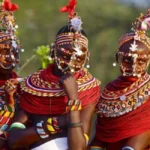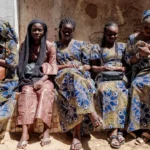Nigeria, often referred to as the “Giant of Africa,” is a country celebrated for its rich cultural diversity, which is vividly reflected in its traditional clothing.
With over 250 ethnic groups, Nigeria offers a wide array of traditional attire, each embodying the history, customs, and identity of the people. From the colorful Aso Oke to the regal Agbada, traditional Nigerian clothing is not just functional but also symbolic, showcasing a perfect blend of art, fashion, and culture.
This article explores the historical roots, regional variations, and cultural significance of Nigerian traditional clothing, providing a comprehensive understanding of its enduring appeal.
Historical Roots of Nigerian Traditional Clothing
Pre-Colonial Era
Before colonization, Nigerian clothing was deeply tied to the environment, with materials derived from locally available resources. Early Nigerians utilized:
See also Traditional Clothing in Kenya: A Reflection of Heritage and Diversity
Traditional Clothing in Kenya: A Reflection of Heritage and Diversity
- Animal skins and leaves: Used primarily by hunter-gatherer communities.
- Handwoven fabrics: Crafted from cotton or raffia fibers, dyed with natural substances like indigo or kola nuts.
- Adire and Akwete textiles: Known for their vibrant patterns and handcrafted techniques, these textiles became staples in many Nigerian societies.
Colonial Influence
The arrival of European traders and missionaries introduced new fabrics like silk and velvet, as well as Western-style tailoring techniques. This era saw a fusion of traditional and foreign styles, giving rise to more elaborate garments worn for special occasions.
Post-Independence Revival
After Nigeria gained independence in 1960, there was a cultural renaissance that celebrated traditional attire as a symbol of national pride and unity. Garments such as the Buba, Wrapper, and Agbada became synonymous with Nigerian identity.
Key Elements of Traditional Nigerian Clothing
For Women
- Gele (Headwrap):
- 👑 A large, decorative headscarf that serves as a statement piece.
- Worn for both casual and ceremonial purposes, often made of stiff fabrics like damask or Ankara.
- Iro and Buba:
- 🧥 A two-piece ensemble consisting of a fitted blouse (Buba) and a wraparound skirt (Iro).
- Often made from Aso Oke or lace fabrics and adorned with embroidery or beadwork.
- Aso Ebi:
- 🎀 A uniform fabric worn by a group to signify solidarity during weddings, funerals, or celebrations.
- Typically made from brightly colored lace, Ankara, or George fabric.
- Beaded Accessories:
- 💎 Women often wear coral beads around their necks, wrists, and ankles, symbolizing wealth and status.
For Men
- Agbada:
- 🧥 A flowing, wide-sleeved robe worn over a tunic and trousers.
- Often reserved for formal occasions and crafted from richly embroidered fabrics.
- Dashiki:
- 🎽 A loose-fitting tunic with intricate embroidery, popular for its comfort and elegance.
- Worn casually or for semi-formal events.
- Fila (Cap):
- 🎩 A traditional cap made from Aso Oke or velvet, often worn to complete formal attire.
- Styles include the Abeti Aja (dog-ear style) and the rounded Kufi.
- Wrapper:
- 👖 Men in some regions wear a wrapper, similar to a sarong, paired with a simple tunic.
Regional Variations in Nigerian Traditional Clothing
Yoruba (Southwest Nigeria)
The Yoruba people are known for their elaborate and colorful attire, which often features Aso Oke, a handwoven fabric. Key clothing items include:
- Agbada and Sokoto: Formal attire for men, featuring an embroidered tunic paired with trousers.
- Iro, Buba, and Gele: A classic outfit for women, often accessorized with gold or coral beads.
Igbo (Southeast Nigeria)
Igbo clothing emphasizes simplicity and elegance, with coral beads playing a central role in traditional attire:
See also Traditional Clothing in Senegal: A Vibrant Expression of Culture and Heritage
Traditional Clothing in Senegal: A Vibrant Expression of Culture and Heritage
- Isiagu Shirt: Worn by men, this embroidered shirt often features lion motifs, symbolizing strength.
- George Wrapper: Women wear a richly patterned wrapper with a matching blouse and headscarf.
- Red Caps: Reserved for titled men, symbolizing leadership and respect.
Hausa-Fulani (Northern Nigeria)
In Northern Nigeria, Islamic influence shapes traditional clothing, emphasizing modesty:
- Kaftan and Babban Riga: Flowing garments worn by men, often accompanied by a turban.
- Hijabs and Abayas: Commonly worn by women, paired with intricate henna designs on their hands and feet.
Niger Delta (South-South Nigeria)
The Niger Delta region showcases unique styles influenced by its riverine culture:
- Etibo: A lightweight shirt worn by men, often paired with trousers and a bowler hat.
- Beaded Gowns: Women wear elaborately beaded dresses, reflecting their status and heritage.
Middle Belt (Central Nigeria)
The Middle Belt region is a melting pot of ethnic groups, each with distinctive clothing traditions:
- Anger Fabric: A handwoven fabric popular among the Tiv people, featuring black and white stripes.
- Beaded Accessories: Used extensively by the Gwari and Idoma people to complement their outfits.
The Cultural Significance of Traditional Nigerian Clothing
Symbol of Identity and Status
Traditional clothing in Nigeria is a marker of social status, ethnic identity, and even marital status. For example:
- Coral Beads: Signify wealth and nobility in many communities.
- Headwrap Styles: Indicate a woman’s marital status or mood.
Expression of Art and Craftsmanship
The production of traditional Nigerian clothing is an art form, involving:
- Weaving: Aso Oke and Akwete fabrics are handwoven on traditional looms.
- Dyeing: Adire fabric is created using resist-dyeing techniques with natural indigo.
- Embroidery: Seen on garments like the Agbada and Isiagu, adding an intricate touch.
Role in Celebrations
Traditional attire plays a central role in Nigerian ceremonies, including:
- Weddings: Couples often wear matching Aso Oke or lace outfits.
- Festivals: Events like the Eyo Festival in Lagos feature performers in white traditional robes.
- Funerals: Attire is chosen to reflect the mood, with darker fabrics used for mourning.
Challenges and Preservation Efforts
Despite its cultural importance, traditional Nigerian clothing faces challenges from globalization and fast fashion. However, efforts to preserve and promote these styles include:
- Fashion Designers: Contemporary designers like Deola Sagoe and Lisa Folawiyo incorporate traditional fabrics into modern designs.
- Cultural Festivals: Events like Nigeria Fashion Week spotlight the beauty of traditional attire.
- Education: Schools and cultural centers teach weaving, dyeing, and sewing techniques.
Celebrating Nigerian Heritage Through Clothing
Traditional clothing in Nigeria is more than just attire; it is a vivid expression of the nation’s rich cultural mosaic. Whether it’s the regal elegance of the Agbada or the vibrant patterns of Ankara, each garment tells a story of heritage, identity, and resilience.
As Nigeria continues to embrace modernity while honoring its roots, traditional clothing remains a powerful symbol of pride and unity. By celebrating and preserving these styles, Nigerians ensure that their cultural legacy endures for generations to come.